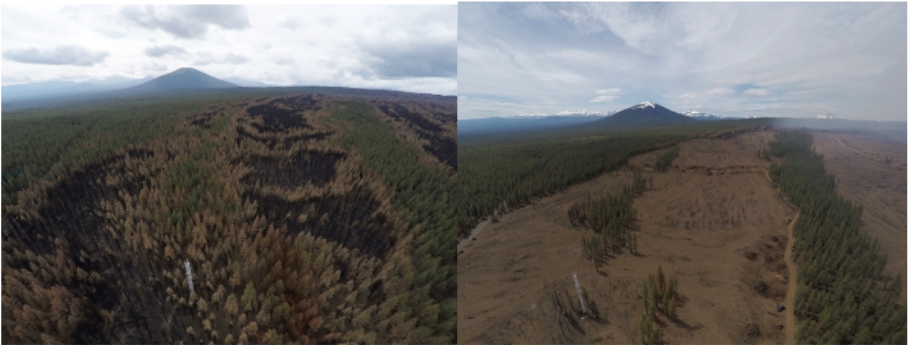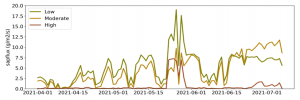The western US has experienced widespread increases in burned area in recent decades (Keeley and Syphard 2018; Bowman et al., 2020). In California and Oregon the largest and most destructive wildfires on record have occurred in just the last few years. The western US has simultaneously been experiencing a megadrought, exacerbated by anthropogenic climate change (Williams et al., 2021) and thus it is common for wildfires to occur in forests that are simultaneously experiencing extreme drought stress. Post-fire mortality and survival dynamics of burned trees has important consequences for carbon, water and energy cycling within ecosystems. While burn severity is a strong predictor of which trees will survive, the drought conditions leading up to and following a fire are likely to play a significant role in post-fire recovery. Consequently, there is an urgent need to better understand the potential ecological and social impacts of compounding drought and wildfire, and to assess risks and potential carbon-climate feedbacks from forested areas.
In August of 2020 a mixed severity fire burned US-Me2, a well-instrumented Ponderosa pine forest where researchers from Oregon State University working with the AmeriFlux network have been monitoring ecosystem carbon, water, and energy cycling and stand characteristics for two decades. This natural experiment presents a rare opportunity to examine fire impacts on ecosystem function and post-fire recovery dynamics. Furthermore, areas of high burn severity were salvage logged in April 2021, which is a common practice on both public and private lands, and replanting took place in June of 2022. These disturbance events have created a system rich with possible science questions (Figure 1).

Figure 1. (left) US-Me2 after mixed severity fire in August 2020 (tower located in the lower left of image) and (right) the tower and site after salvage logging was conducted in April 2021.
While much of the monitoring equipment was destroyed in the fire, instruments located high up on the tower were spared and the AmeriFlux team at Oregon State University had the eddy-covariance system back up and running within days after the fire. A rapid deployment site was established in an area of low burn severity and trees across a range of burn severities were instrumented with sapflux sensors. These efforts have enabled researchers to examine the resilience of trees experiencing different degrees of burn severity. High intensity crown fires can lead to immediate mortality when the canopy is consumed, but low to moderate severity fires can also cause cambium and foliage damages which can impede tree function and eventually lead to tree mortality. Even when trees are able to recover, fire damages can cause prolonged periods of reduced functionality, leaving trees vulnerable to compounding stressors. Drought conditions in the years following a wildfire can impede recovery or even exacerbate mortality when physiological tipping points are reached, and trees cannot recover. Similarly, drought conditions preceding a fire can inhibit hydraulic function and reduce resilience to fire-induced injuries.
Sapflux velocity is a measure of tree water use and can be used as an indicator of photosynthetic activity and hence tree recovery. Preliminary data from this site indicate that trees in areas of low burn severity retained high maximum sapflow rates and hence photosynthetic rates, due to the retention of most foliage (Figure 2). It appears that trees in areas of moderate burn severity may have benefited in the late growing season from reduced competition after understory plants died, or alternatively those trees were able to recover hydraulic function by the end of the growing season. Trees in areas of high burn severity still retained some foliage and were briefly active, but it is likely that net negative carbon balances and hydraulic damage will lead to eventual mortality in these trees.

Figure 2. Average daytime (10am – 3pm) sapflux in trees with low (6 tree mean), moderate (6 tree mean), and high (4 tree mean) burn severity during the growing season following the burn (2021).
Decades of carbon and water monitoring will be invaluable as we assess the impacts of wildfire and logging at this well-studied forest site, which is broadly representative of similar semi-arid Ponderosa pine forests in the American West. Without the support of the AmeriFlux network, this research would not be possible.

No Comments
Be the first to start a conversation